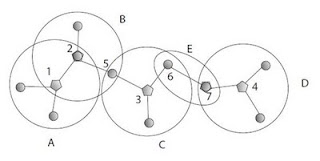It is widely anticipated that fourth-generation wireless systems will extensively rely on the unlicensed operations provided by ad hoc communications Allowing spontaneous deployment and self-planning/management, ad hoc networking will play an important role in delivering all kinds of wireless services from the Internet to the very hands of the mobile user. The Bluetooth (BT) technology, as described in the Specifications of the Bluetooth System, Version 1.1, is expected to be one of the most promising enabling technologies for ad hoc networks. Originally introduced as short-range cable replacement, the BT specifications define ways that each BT device can set up multiple connections with neighboring devices so that communication can be established in a multihop fashion. In this sense, Bluetooth devices spread out in a geographic area can provide the missing wireless extension to the various heterogeneous network infrastructures, allowing a more pervasive wireless access.
According to the specifications, when two BT nodes that are in each others’ communication range want to set up a communication link, one of them must assume the role of master of the communication while the other becomes its slave. This simple “one-hop” network is called a piconet and may include several slaves, no more than seven of which can be actively communicating with the master at the same time. If a master has more than seven slaves, some slaves have to be “parked.” To communicate with a parked slave, a master has to “un-park” it, while possibly parking another slave.
The specifications allow each node to assume multiple roles. A node can be a master in one piconet and a slave in one or more other piconets, or a slave in multiple piconets. Devices with multiple roles act as gateways to adjacent piconets, thus creating a multihop ad hoc network called a scatternet.
The illustration above shows the case in which 13 BT devices have been partitioned into four piconets (A, B, C, and D). Masters are represented by pentagons (surrounded by a large circle that represents their transmission radius), whereas slaves are depicted as small circles. Adjacent piconets can be interconnected in different ways. Piconets A and B depict the master–master case, when two masters are neighbors and interconnection is achieved by having one of the two masters joining the piconet of the other as a slave (in the figure, node 2 became the slave of node 1). Two piconets can be joined by a common slave, termed a gateway slave. This is the case of piconets B and C, which are joined by node 5. The third case is when piconets are interconnected through a pair of neighboring slaves, called in the following intermediate gateways, as in the case of piconets C and D, joined by nodes 6 and 7. In the latter case, interconnection requires that one of the two intermediate gateways becomes the master of a new piconet that includes the other intermediate gateway as a slave (in the figure, node 7 becomes the master of the extra piconet). With the creation of piconet E, the five piconets of Figure 4.1 form a connected scatternet.
In short Piconets can be interconnected through gateways into a multihop ad hoc network called a scatternet. And Piconet formation is performed in two steps: first, devices must become aware of their neighboring nodes, that is, the nodes in their transmission range (device discovery); then, information must be exchanged to set up a link between a candidate slave and a candidate master (link establishment).




